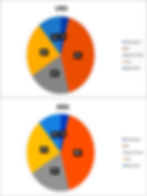Changes in The Proportions of Energy Produced - IELTS Task 1 Multiple Graphs Band 9 Sample Report
- IELTS Luminary
- Oct 9, 2022
- 3 min read
Updated: Jul 3, 2024
You should spend about 20 minutes on this task.
The pie charts indicate changes in the proportions of energy produced in a country from 1983 to 2003.
Summarize the information by selecting and reporting the main features, and make comparisons where relevant.
Write at least 150 words.

Get your personalised IELTS Essay Feedback from a former examiner
Download IELTS eBooks, get everything you need to achieve a high band score
Sample Report 1
The provided pie charts detail the shifts in energy production composition within a specific country across two decades, 1983 and 2003.
Notably, while oil remained the predominant energy source across the two sampled years, its share displayed a modest decrease. Simultaneously, the proportionate contributions of nuclear power and natural gas saw upward trends, contrasting with the decline in coal's percentage.
In 1983, oil was the dominant energy source, accounting for 42% of total production. Coal followed with a 23% share, and nuclear power contributed 20%. The lesser components were natural gas at 11% and hydropower, which made up a minimal 4% of the energy mix. By 2003, there was a noticeable shift in the energy landscape. Oil's dominance decreased slightly to 38%, while nuclear power's share increased to 24%.
Furthermore, there was a significant transition in the contributions of coal and natural gas. Coal's share dramatically decreased from 23% in 1983 to just 13% in 2003. In contrast, the proportion of natural gas nearly doubled, rising from 11% to 21% over the same period. Hydropower's contribution to the country's energy production remained unchanged at 4%, underscoring its consistent yet limited role in the overall energy framework.
Download IELTS eBooks, get everything you need to achieve a high band score
Sample Report 2
The pie charts provide an analysis of changes in the energy production mix of a certain country over the span of two decades, specifically between 1983 and 2003.
The data shows that oil, while still the principal source of energy in both years, experienced a slight decrease in its share of total energy production. Concurrently, there was a noticeable rise in the shares of nuclear power and natural gas, which contrasted starkly with the decline observed in the contribution from coal.
In the year 1983, oil was at the forefront, constituting 42% of the nation's energy output. This was followed by coal at 23% and nuclear power, which made up 20%. The smaller shares were held by natural gas at 11% and hydropower at 4%. Fast forward to 2003, and the energy profile had visibly shifted. The share of oil had reduced to 38%, whereas nuclear power had increased its presence to 24%.
Additionally, the data from 2003 indicates a significant shift in the roles of coal and natural gas within the energy sector. The proportion of energy derived from coal saw a notable reduction, falling from 23% to 13%. On the other hand, natural gas almost doubled its share, escalating from 11% to 21%. The share of hydropower remained constant at 4%, highlighting its steady yet minor role in the country’s energy portfolio.
Sample Report 3
The pie diagrams present data on the composition of energy production in a certain country in two distinct periods, 1983 and 2003.
Overall, oil constituted the largest proportion of energy produced in the nation in both years, while the proportional share of coal and natural gas experienced a significant change.
In both years, 1983 and 2003, oil was the dominant energy source, making up about 40% of total production, followed by coal at 23% in 1983 and nuclear power at 24% in 2003. However, the drop of oil dominance and the rise in nuclear power are noticeable, as oil’s contribution in energy sector reduced from 42% in 1983 to 38% in 2003, and the share of nuclear power rose from 20% in 1983 to 24% in 2003.
However, by 2003, the scenario had shifted dramatically for both coal and natural gas. The percentage of coal energy was 23 percent in 1983, which remarkably dropped to 13% in 2003, while the share of natural gas in the nation’s energy contribution considerably increased from 11% in 1983 to 21% in 2003, depicting the nation’s obvious move from coal towards natural gas for its energy composition. However, the contribution of Hydropower in the nation’s energy generation remained the same (4%) in both periods.
Get your personalised IELTS Essay Feedback from a former examiner
Download IELTS eBooks, get everything you need to achieve a high band score
